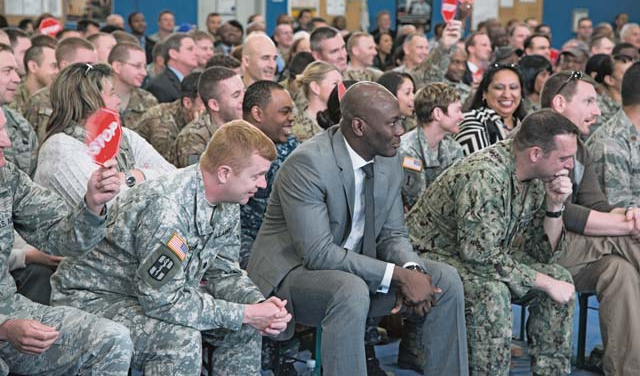
Sex Signals
Sexual Harassment and Assault Prevention for the New Service Member.
Contact UsBeginning the Discussion
Sex Signals has become the most popular sexual assault prevention program on military installations and has been seen by over two million service members. It differs from traditional sexual assault prevention programs in that it incorporates improvisation, humor, education, and audience interaction to provide a provocative look at dating, sex, and the core issue of consent and bystander intervention.
A two-person team of highly-trained educators takes the audience on an interactive exploration of the cultural messaging we receive about gender, sexuality, sexual health, and intimate relationships. It examines what roles culture and identity play in justifying unhealthy and dangerous beliefs about what is acceptable social and sexual behavior. This is all accomplished through facilitated dialogue and several semi-improvisational scenes that lead to a focused discussion on the role we all can play in ending sexual violence. Audiences will be able to positively change the way they think, communicate, and act by encouraging bystander intervention in all aspects of their life.
Take your Training to the Next Level
Everyone is part of the solution to reducing harm and creating a culture of respect. Contact us to request a free demo and to learn more about this program.
Learning Objectives
-
The definitions of sexual assault and rape.
-
Consent must be active, verbal, and ongoing and cannot be obtained from someone who is incapacitated (by alcohol, drugs, etc.).
-
The sexual initiator is responsible for being certain that consent is present.
-
People of all gender identities can be victims and perpetrators of sexual assault and rape.
-
The perpetrator alone (not the victim) is 100% responsible for sexual assault.
-
There are important differences between risk reduction strategies and rape prevention.
-
Sexual assault is much more than a crime; it is a moral issue.
-
As representatives of the United States military, service men and women have a responsibility to intervene when they witness sexually aggressive behavior, on base or off.
-
A stand against sexual violence aligns with each branch's Core Values.
Are you ready to put ethics into action?

Our Programs
Innovative prevention education programming for civilian and military audiences.
-
New Service Member Sex Signals
Sexual Harassment and Assault Prevention for the New Service Member
-
Experienced Service Member Got Your Back
Sexual Harassment and Assault Prevention for the Experienced Service Member
Learn More -
Transfer Capacity Force of Awesome Institute
The Force of Awesome Institute takes prevention educators from good to great
Learn More -
Service Member in Leadership Beat the Blame Game
Sexual Harassment and Assault Prevention for Service Members in Leadership
Learn More -
Service Member in Command The Canary in the Coal Mine
Sexual Harassment and Assault Prevention for Service Members in Command
Learn More
